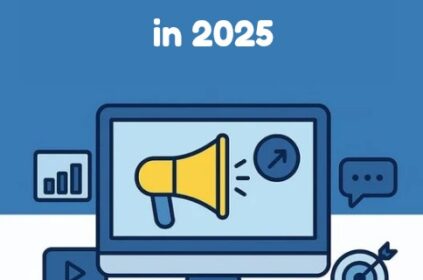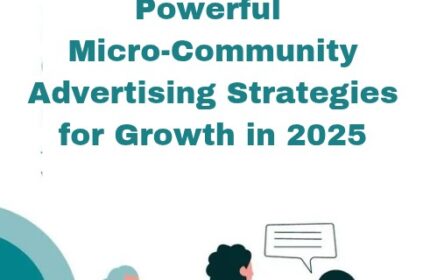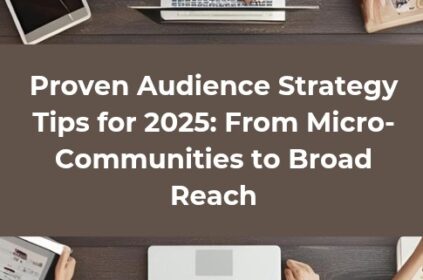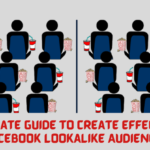Have you ever meticulously crafted a Facebook Ad campaign, only to witness underwhelming performance metrics? Do you seek to elucidate the factors that differentiate exceptional ad performance from an expenditure inefficiency? Perhaps you find yourself perplexed by the myriad of Facebook Ad metrics (CTR, CPC, CPM, etc.)?
Within the contemporary digital marketing landscape, organizations that meticulously assess and analyze their advertising performance exhibit a demonstrably superior return on investment (ROI).
In fact, such data-driven entities are 30% more likely to achieve improved ROI compared to their counterparts who neglect this critical aspect. This compelling statistic underscores the paramount importance of comprehending Facebook Ad metrics.
This blog post presents a comprehensive guide designed to cultivate a profound understanding and interpretation of these metrics. By empowering you with this knowledge, you will be equipped to make data-driven choices that optimize the effectiveness of your advertising campaigns.
Through the mastery of key metrics such as Click-Through Rate (CTR), Cost Per Click (CPC), Cost Per Thousand Impressions (CPM), Conversion Rate, and Return on Ad Spend (ROAS), you can refine your Facebook Ads to achieve superior outcomes and maximize the return on your marketing budget.
Throughout this guide, we will explain each of these metrics in detail, elucidate their significance, and offer practical strategies for leveraging them to your advantage. By the conclusion of this article, you will possess a well-grounded understanding of how to measure success within your Facebook Ad campaigns, and you will be equipped with the tools necessary to continually enhance your advertising strategies.
Benefits of Understanding Facebook Ad Metrics

Effectively tracking and analyzing Facebook ad performance is no longer optional – it is a fundamental requirement for success. Facebook Ad metrics offer a treasure trove of valuable insights that illuminate the effectiveness of your campaigns, empowering you to make data-driven decisions and optimize your marketing efforts for maximum impact.
Here’s a breakdown of the key benefits reaped by leveraging Facebook Ad metrics:
#1. Enhanced decision-making: By meticulously analyzing key performance indicators (KPIs) such as click-through rate (CTR) and cost per click (CPC), you can gain invaluable insights into user behavior and identify trends within your campaigns.
This data allows you to make informed adjustments to your strategies, refining your approach based on real-world performance. For instance, a high CTR coupled with a low conversion rate might indicate a compelling ad that requires a corresponding improvement on the landing page or offer.
#2. Optimized Ad Performance: Facebook Ad metrics equip you with the tools to continuously refine your campaigns and maximize their effectiveness. Metrics like cost per thousand impressions (CPM) help you determine the most cost-efficient way to reach your target audience.
By analyzing these metrics and identifying areas for improvement, you can ensure your ads not only reach the right people but also resonate with them, ultimately leading to higher engagement and conversions.
#3. Measurable ROI: A cornerstone of any successful marketing campaign is the ability to quantify its return on investment (ROI). Facebook Ad metrics provide invaluable insights into this crucial aspect. By tracking metrics like return on ad spend (ROAS), you can precisely measure the revenue generated from your ads in relation to the amount invested.

This clear picture of your campaign’s profitability allows you to assess its overall effectiveness and identify areas for improvement. A high ROAS indicates a successful campaign generating significant revenue compared to its cost. Conversely, a low ROAS might necessitate a strategic shift in your targeting parameters, creative elements, or overall ad strategy.
#4. Improved Targeting and Audience Insights: Facebook Ad metrics go beyond simply measuring clicks and conversions. They provide valuable demographic data about the users who are engaging with your ads.
This allows you to refine your audience targeting over time, ensuring you reach the individuals most likely to convert. Understanding the demographics of your most engaged audience segments can also inform broader marketing strategies and content creation.
#5. A/B Testing and Creative Optimization: Facebook Ads Manager offers robust A/B testing functionalities. By leveraging Facebook Ad metrics, you can objectively compare the performance of different ad variations, including headlines, visuals, and calls to action. This data-driven approach allows you to identify the most effective creative elements and optimize your ad campaigns for superior results.
#6. Benchmarking and Competitive Analysis: While maintaining a focus on your own campaign goals, Facebook Ad metrics can also offer insights into competitor activity.
By analyzing publicly available data on competitor ad campaigns within your industry, you can identify audience targeting strategies, ad formats, and messaging approaches that resonate with your target demographic. This knowledge can inform your own campaign development and potentially help you gain a competitive edge.
#7. Demonstrate Campaign Value: When it comes to reporting and justifying marketing budgets, Facebook Ad metrics provide concrete data to showcase the value of your advertising efforts.
By demonstrating campaign performance metrics like reach, engagement, and conversions, you can effectively communicate the impact of your campaigns to stakeholders and secure continued support for your marketing initiatives.
#8. Reduced Ad Fatigue: Excessive exposure to the same ad creative can lead to ad fatigue, causing users to become blind to your message. By tracking metrics like frequency (number of times a user sees your ad) and analyzing audience engagement, you can identify when ad fatigue might be setting in.
This allows you to proactively refresh your ad creatives and maintain audience interest over longer campaigns.
#9. Identify New Opportunities: Facebook Ads metrics can reveal hidden trends and patterns within your campaign data. By analyzing metrics like location data and engagement by device, you might uncover new target audiences or discover opportunities to expand your reach into previously unexplored demographics or geographic regions.
#10. Prioritize Content Creation: Understanding which types of content resonate most with your audience through ad engagement metrics can inform your broader content creation strategy. This allows you to focus on developing content formats and topics that are most likely to generate organic engagement and brand loyalty beyond paid advertising efforts.
By understanding and leveraging these powerful metrics, you can transform your Facebook advertising endeavors from a guessing game into a data-driven success story. You’ll not only optimize your ad performance and maximize ROI, but also ensure your marketing efforts are both efficient and effective in achieving your business goals.
Key Facebook Ad Metrics
#1 Click-Through Rate (CTR)
Click-Through Rate (CTR) is a metric that measures the percentage of people who click on your ad after seeing it. It is calculated by dividing the number of clicks on the ad by the number of impressions (the number of times the ad is shown) and then multiplying by 100 to get a percentage. The formula for CTR is:
CTR= (Number of Clicks/Number of Impressions)×100
For example, if your ad received 50 clicks and 1,000 impressions, the CTR would be 5%. Check our CTR Free Calculator
Importance of a High Click-Through Rate (CTR) in Facebook Ads:
#1. Indicates Relevance and Appeal: A high CTR signifies that your ad resonates with your target audience. A significant portion of those who see your ad find it relevant and compelling enough to click on it.
#2. Drives Traffic: A high CTR translates to more people clicking through to your desired destination, whether it’s a landing page, website, or other call to action. This increases the potential for conversions and achieving your campaign goals.
#3. Boosts Ad Algorithm Performance: Facebook’s ad algorithm prioritizes ads that generate high engagement. A strong CTR signals that your ad is engaging, leading to a potentially improved relevance score.
#4. Reduces Ad Costs: Facebook rewards ads with high relevance scores by giving them better ad placement and potentially lowering costs. This allows you to stretch your advertising budget further.
#5. Improves Brand Awareness: Even if users don’t click through, a high CTR indicates that your ad is stopping them in their scroll and grabbing their attention. This repeated exposure can increase brand awareness and recognition among your target audience.
#6. Provides Valuable A/B Testing Data: High CTRs in A/B testing scenarios clearly indicate which ad variations are most successful in capturing user interest. This data allows you to refine your ad creatives and messaging for future campaigns.
#7. Uncovers Targeting Optimization Opportunities: A low CTR for a specific audience segment within your broader targeting might indicate a need for refinement. By analyzing which demographics or interests are associated with lower CTRs, you can adjust your targeting parameters to reach a more receptive audience.
#8. Offers Potential for Organic Reach: High engagement with your ads, as reflected by a strong CTR, can sometimes lead to organic reach. Facebook may show your ad to users within the social circles of those who have already interacted with it, expanding your reach without additional paid promotion.
#9. Provides Early Campaign Insights: A high CTR early in a campaign can be a positive indicator of overall performance. It suggests that your ad is resonating with your target audience and has the potential to deliver strong results throughout the campaign duration.
In essence, a high CTR signifies a well-crafted ad that effectively captures your audience’s attention and motivates them to take action. It benefits your campaign by driving traffic, improving ad performance within the algorithm, potentially reducing costs, and offering additional benefits like brand awareness and organic reach.
Optimization Tips for High CTRs in Facebook Ads
A high Click-Through Rate (CTR) is the lifeblood of a successful Facebook Ad campaign. It signifies that your ad is capturing attention, sparking interest, and motivating users to click through to your desired destination. Here’s a breakdown of key optimization strategies to elevate your CTR and maximize the effectiveness of your Facebook Ads:
#1. Compelling Ad Copy
I. Clear, Concise, and Persuasive: Craft ad copy that cuts through the noise of the Facebook feed. Use clear and concise language that instantly communicates your value proposition. Highlight the key benefits of your product or service and address the specific pain points your target audience is facing.
II. Strong Call to Action (CTA): Don’t leave users guessing about what you want them to do next. Include a clear and action-oriented call to action (CTA) in your ad copy. Whether it’s “Learn More,” “Shop Now,” “Download Now,” or “Sign Up Today,” your CTA should be direct and persuasive, prompting users to click through and engage with your offering.
#2. High-Quality Images and Videos:
- Eye-Catching Visuals: In the visually driven world of social media, visuals are paramount. Use high-quality images or videos that grab attention and stand out within the Facebook feed. Consider using bright colors, strong compositions, and visuals that are directly relevant to your ad message.
- Resonance with Target Audience: Don’t just use any image or video. Ensure your visuals resonate with your target audience. This could involve featuring people who represent your ideal customer or showcasing products or services used in real-world scenarios that your audience can relate to.
#3. Targeting the Right Audience:
I. Facebook’s Targeting Options: Facebook offers a robust suite of targeting options that allow you to reach a highly relevant audience for your campaigns. Utilize demographic targeting to reach users based on age, gender, location, income, and other relevant factors.
Leverage interest targeting to connect with users who have expressed interest in specific topics, hobbies, or brands that align with your offering. Behavioral targeting allows you to target users based on their past actions and online activity, further increasing the likelihood that your ad resonates with them.
II. Custom Audiences: Take audience targeting a step further by creating custom audiences. This allows you to upload your existing customer email lists or website visitor data to target users who have already interacted with your brand.
You can also create lookalike audiences based on your existing customer base to reach new users who share similar characteristics, increasing the potential for high CTRs and conversions.
#4. A/B Testing:
Comparing Different Ad Variations: Don’t settle for assumptions about what will resonate with your audience. A/B testing allows you to compare different versions of your ad creatives and messaging to see which combinations perform best.
Test variations in headlines, ad copy, images, videos, and CTAs. By analyzing the results of your A/B tests, you can identify the elements that drive the highest CTR and optimize your ads for maximum impact.
#5. Ad Placement Optimization:
Experimenting with Placement Options: Facebook Ads can be displayed across various placements within the platform, including the News Feed, Stories, Marketplace, and Right Column. Each placement caters to a slightly different user mindset and browsing behavior.
Experiment with different placements to discover where your target audience is most receptive to your message. Analyze the performance of your ads across each placement and allocate your budget to the placements that generate the highest CTR and conversions.
By focusing on these optimization strategies, you can craft Facebook Ads that are more appealing, relevant, and likely to capture user attention. This translates to a higher CTR, increased traffic to your landing page or website, and ultimately, more effective and successful Facebook Ad campaigns that achieve your marketing goals.
#2 Cost Per Thousand Impressions (CPM)
Cost Per Thousand Impressions (CPM) is a metric that measures the cost of your ad per 1,000 impressions. An impression is counted each time your ad is shown to a user. The formula for calculating CPM is:
CPM= (Total Cost of the Ad/Total Impressions)×1,000
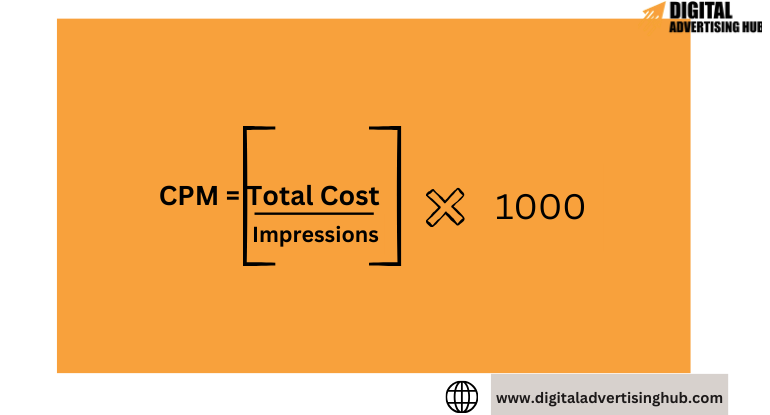
For example, if you spent $50 on an ad campaign that received 10,000 impressions, your CPM would be $5.
Importance of Cost Per Mille (CPM) in Facebook Ads:
While Click-Through Rate (CTR) is essential for measuring user engagement with your ad, Cost Per Mille (CPM) plays a crucial role in understanding the efficiency of reaching your target audience. Here’s a breakdown of the key reasons why CPM is an important metric to consider in your Facebook Ad campaigns:
#1. Gauges Brand Awareness Reach: CPM is particularly relevant for brand awareness campaigns where the primary goal is to maximize visibility and build brand recognition among a large audience. By tracking your CPM, you can assess how much you’re spending to get your ad seen by 1,000 people.
#2. Optimizes Budget Allocation: A lower CPM translates to reaching a wider audience for the same budget. This allows you to stretch your marketing dollars further and maximize the overall reach and impact of your brand awareness campaign.
#3. Provides Benchmarking Insights: Analyzing your CPM over time and comparing it to industry benchmarks can offer valuable insights. You can identify trends and determine if your CPM is within a reasonable range for your campaign goals and target audience.
#4. Informs Targeting Strategy Adjustments: A high CPM might indicate that your targeting parameters are too broad or not reaching the most receptive audience. By analyzing your CPM alongside other metrics like demographics and interests, you can refine your targeting strategy to reach a more relevant audience at a potentially lower cost.
#5. Contributes to Funnel Optimization: Brand awareness campaigns, measured through CPM, often serve as the top of the marketing funnel, piquing user interest. By tracking CPM alongside metrics lower in the funnel, such as conversion rate, you can assess the overall effectiveness of your marketing efforts in driving users from initial brand awareness to taking a desired action.
Understanding and optimizing your CPM is crucial for running cost-effective brand awareness campaigns on Facebook. It allows you to efficiently reach a large audience, maximize brand visibility, and ultimately contribute to a successful marketing funnel that drives conversions.
Strategies to Reduce Cost Per Mille (CPM) in Facebook Ads
Cost per Mille (CPM) is a vital metric in Facebook Ads, particularly for brand awareness campaigns. It indicates how much you spend to get your ad seen by 1,000 people. A lower CPM allows you to reach a broader audience for the same budget, maximizing your campaign’s reach and impact. Here are key optimization strategies to achieve a lower CPM:
#1. Audience Targeting:
I. Refine Targeting Parameters: Broad targeting casts a wide net but might not be the most cost-effective approach. By narrowing your audience to those most likely to be interested in your brand, you can reduce wasted impressions and decrease your CPM.
Utilize Facebook’s demographic targeting options to focus on users based on age, location, income, and other relevant factors. Leverage interest targeting to reach users who have expressed interest in specific topics or brands that align with your offering.
II. Lookalike Audiences: Lookalike audiences allow you to expand your reach beyond your existing customer base. Facebook helps you identify new potential customers who share similar characteristics with your existing clientele. Targeting lookalike audiences increases the likelihood that your ad resonates with them, leading to higher engagement and potentially lowering your CPM.
#2. Ad Relevance:
I. Content Tailored to Audience: The relevance of your ad content significantly impacts your CPM. Ads that resonate with your target audience are more likely to capture attention and generate engagement. Tailor your ad copy, visuals, and messaging to directly address the specific needs, interests, and pain points of your target demographic.
II. High-Quality Visuals and Compelling Copy: People are more likely to stop and engage with visually appealing and informative ads. Invest in high-quality visuals that are relevant to your message and resonate with your target audience. Craft compelling ad copy that is clear, concise, and effectively communicates your value proposition.
#3. Ad Scheduling:
Target Active Audience Times: Running your ads during times when your target audience is most active on Facebook can significantly improve your CPM. Analyze your audience insights and past campaign data to identify the days and times when your target demographic is most engaged on the platform.
Schedule your ads to run during these peak hours to maximize the chances of reaching receptive users and potentially lowering your CPM.
#4. Ad Placement Optimization:
I. Experiment with Different Placements: Facebook Ads offer various placements within the platform, including the News Feed, Stories, Marketplace, and Right Column. Each placement caters to a slightly different user mindset and browsing behavior. Experiment with running your ads across various placements to discover where your target audience is most receptive to your message and where you achieve the lowest CPM.
II. Budget Allocation Based on Performance: Don’t spread your budget equally across all placements. Analyze the performance of your ads across each placement, paying attention to metrics like CPM and engagement.
Allocate a higher portion of your budget to the placements that generate the lowest CPM and the highest engagement rate. This ensures you reach your target audience efficiently and maximize the impact of your campaign.
By implementing these optimization strategies, you can significantly reduce your CPM in Facebook Ads. This allows you to stretch your marketing budget further, reach a wider audience, and achieve your brand awareness goals more effectively.
#3 Conversion Rate
Conversion rate is a metric that measures the percentage of users who take a desired action after clicking on your ad. This action can be anything from making a purchase to signing up for a newsletter. The formula for conversion rate is:
Conversion Rate= (Number of Conversions/Number of Clicks )×100
For example, if your ad received 200 clicks and resulted in 20 conversions, your conversion rate would be 10%.
Importance of Conversion Rate in Facebook Ads:
The conversion rate is a critical metric in Facebook Ads. It signifies the percentage of users who see your ad and take a desired action, such as making a purchase, signing up for a newsletter, or downloading an app. Here’s a breakdown of why conversion rate is such a critical metric:
#1. Measures Ad Effectiveness: Conversion rate is a direct reflection of how well your ad is performing in achieving your marketing goals. A high conversion rate indicates that your ad is successfully capturing attention, generating interest, and ultimately motivating users to take action. Conversely, a low conversion rate suggests areas for improvement in your ad or landing page.
#2. Maximizes ROI (Return On Investment): Facebook Ads are an investment, and conversion rate is a key metric for gauging your return. By tracking conversions, you can directly measure the revenue or leads generated from your ad spend.
A high conversion rate translates to a higher ROI, signifying that your ad campaign is effectively generating a return on your investment.
#3. Informs Landing Page Optimization: The conversion rate doesn’t solely depend on the ad itself. A well-crafted ad can drive users to the landing page, but if the landing page is confusing or doesn’t effectively guide users towards the desired action, the conversion rate will suffer.
Analyzing your conversion rate can help identify weaknesses in your landing page and inform optimization strategies to improve the user journey and increase conversions.
#4. A/B Testing Optimization: A/B testing different ad variations and landing page elements allows you to identify the most effective combinations for driving conversions. By analyzing how changes to headlines, visuals, CTAs, or landing page content impact conversion rate, you can optimize your campaigns for maximum results.
#5. Provides Audience Insights: While conversion rate is an overall campaign metric, it can also be analyzed by demographics or audience segments. This can reveal valuable insights into which audience segments convert at a higher rate. This allows you to refine your targeting strategy to focus on the demographics most likely to convert, ultimately improving your overall conversion rate and campaign effectiveness.
By closely monitoring and optimizing your conversion rate, you can ensure your Facebook Ads are not just reaching a broad audience but actively driving users to take the desired actions that contribute to your marketing goals and maximize your return on investment.
Optimizing for Conversions: Strategies to Boost Your Facebook Ad Conversion Rate
Conversion rate is the lifeblood of successful Facebook Ads. It signifies the percentage of users who see your ad and take a desired action, like making a purchase, signing up for a service, or downloading an app. Here’s a breakdown of key optimization strategies to elevate your conversion rate and maximize the return on your Facebook Ad investment:
#1. Landing Page Optimization:
I. Seamless User Experience: A well-designed landing page is an extension of your ad. Ensure your landing page visually aligns with your ad and provides a clear, seamless user experience. The user should instantly understand the value proposition presented in the ad and be guided effortlessly towards taking the desired action.
II. Clarity and Appeal: Landing pages should be free of clutter and distractions. Use clear and concise headlines that reiterate the message from your ad. Craft compelling CTAs (Call to Action) that are direct, persuasive, and leave no room for confusion about what you want users to do. Visually appealing design elements like high-quality images and videos can further enhance user engagement and encourage action.
#2. A/B Testing:
I. Data-Driven Optimization: Don’t settle for assumptions about what resonates with your audience. A/B testing allows you to scientifically compare different versions of your ad creatives and landing page elements to see which combinations perform best in terms of driving conversions.
Test variations in ad copy headlines, visuals, CTAs, and landing page elements like layout, content structure, and CTA placement. Analyze the results of your A/B tests to identify the winning combinations that generate the highest conversion rates.
II. Continuous Improvement: A/B testing is an ongoing process. As you gather data and identify effective elements, you can continue to refine your ads and landing pages for even better results. This data-driven approach ensures your campaigns are constantly evolving and optimized to maximize conversions.
#3. Audience Targeting:
I. Reach the Right People: The right audience is key to achieving conversions. Refine your audience targeting parameters to ensure you’re reaching users who are most likely to be interested in your offering and convert after seeing your ad.
Leverage demographic targeting options, interest-based targeting, and behavioral targeting to reach users who closely align with your ideal customer profile.
II. Retargeting Campaigns: Retargeting allows you to reach users who have already interacted with your brand in some way, perhaps by visiting your website or engaging with a previous ad. These users are already familiar with your brand and might be more receptive to your message.
Utilize retargeting campaigns to showcase targeted offers or highlight specific benefits that resonate with their past browsing behavior, potentially increasing your conversion rate.
#4. Ad Messaging:
- Value Proposition and Benefits: Craft ad copy that clearly communicates the value proposition of your product or service. Focus on highlighting the benefits that matter most to your target audience and address their specific pain points. Ensure your messaging aligns with the landing page content to create a cohesive user experience.
- Urgency and Scarcity Tactics: People are naturally motivated by a sense of urgency and limited availability. Consider incorporating these tactics into your ad messaging strategically. This could involve highlighting limited-time offers, showcasing limited quantities of a product, or creating a sense of exclusivity to encourage users to take immediate action and convert before the offer expires or the opportunity disappears.
By implementing these optimization strategies, you can ensure your Facebook Ads are not just reaching a broad audience but effectively converting that audience into paying customers, leads, or engaged users, ultimately maximizing the return on investment (ROI) of your Facebook Advertising efforts.
#4 Return on Ad Spend (ROAS)
Return on Ad Spend (ROAS) is a metric that measures the revenue generated from your ad campaigns relative to the amount spent. It helps you determine the profitability of your ads. The formula for ROAS is:
ROAS= Revenue from Ads/Cost of Ads
For example, if you spent $100 on ads and generated $500 in revenue, your ROAS would be 5, indicating that for every dollar spent on ads, you earned $5 in revenue.
Importance of Return On Ad Spend (ROAS) in Facebook Ads
While conversion rate signifies how well your ad drives actions, ROAS (Return On Ad Spend) takes a step further and reveals the financial health of your Facebook Ad campaigns. Here’s a breakdown of why ROAS is a crucial metric to consider:
#1. Profitability and Efficiency: ROAS goes beyond basic conversion rates. It provides a clear picture of the financial performance of your ad campaigns. By calculating ROAS (revenue generated divided by ad spend), you can assess how much revenue each dollar spent on advertising is generating. This allows you to identify profitable campaigns and optimize those that might be lagging behind.
#2. Campaign Success Benchmark: A higher ROAS generally indicates a more successful and profitable campaign. While there’s no single “perfect” ROAS that applies universally, you can establish benchmarks based on your industry, advertising goals, and profit margins. This allows you to gauge the relative success of your campaigns and identify areas for improvement.
#3. Budget Allocation Optimization: Understanding ROAS empowers you to make informed decisions about your ad budget allocation. By comparing the ROAS of different campaigns, you can prioritize allocating more budget to campaigns that generate a higher return on your investment. This ensures you’re maximizing the financial impact of your overall advertising efforts.
#4. Informs Bidding Strategies: Facebook Ads often utilize automated bidding strategies. By analyzing ROAS alongside other metrics, you can refine your bidding strategy to optimize ad delivery. For example, if a campaign has a high ROAS, you might consider setting a higher bid to ensure your ad reaches a wider audience with the potential for even greater returns.
#5. Long-Term Growth Strategy: Focusing solely on short-term wins can be detrimental. A strong ROAS not only indicates a profitable campaign but also provides valuable insights to inform your long-term growth strategy. By analyzing ROAS trends over time, you can identify what elements contribute to higher returns and use this knowledge to refine your future marketing efforts for sustained success.
By closely monitoring and optimizing your ROAS, you can ensure your Facebook Ads are not just generating clicks and conversions but also delivering a positive return on investment. This allows you to make data-driven decisions, optimize your advertising spend, and achieve your long-term marketing goals.
Optimization Tips: To improve your ROAS, consider these strategies:
#1. Targeting and Segmentation:
- Use precise targeting to reach high-value audiences most likely to convert.
- Segment your audience based on behavior, interests, and demographics to deliver more personalized ads.
#2. Ad Creative and Messaging:
- Develop compelling ad creatives that highlight the unique selling points of your products or services.
- Use strong CTAs and persuasive copy to drive conversions.
#3. Budget Allocation:
- Allocate more budget to high-performing campaigns and ad sets.
- Continuously monitor and adjust your budget based on performance data.
#4. Conversion Tracking:
- Implement robust conversion tracking to accurately measure the impact of your ads.
- Use the data to identify and optimize the best-performing elements of your campaigns.
#5. Retargeting Campaigns:
- Use retargeting to reach users who have interacted with your brand but haven’t converted.
- Offer personalized incentives, such as discounts or exclusive offers, to encourage conversions.
Additional Facebook Ad Metrics to Consider
#1 Impressions and Reach
Impressions refer to the number of times your ad is displayed on a user’s screen. Each time your ad is shown, it counts as one impression.
Reach: Reach represents the total number of unique users who have seen your ad at least once. It measures the size of your potential audience.
Importance of Impressions and Reach in Facebook Ads
Understanding how many people see your ad (impressions) and how many unique individuals are exposed to it (reach) is crucial for evaluating the effectiveness of your Facebook Ad campaigns. Here’s a breakdown of why both metrics matter:
#1. Impressions: Gauge Ad Exposure and Visibility
Impressions tell you how often your ad is being displayed on users’ Facebook feeds or other placements. A high number of impressions indicates your ad is gaining exposure and has the potential to reach a wide audience.
By monitoring impressions, you can assess how visible your ad is within your target audience. A low number of impressions might suggest your targeting parameters are too narrow or your bid is too low, limiting your ad’s visibility.
#2. Reach: Understand Overall Ad Impact and Potential Audience
Reach quantifies the number of unique users who have seen your ad at least once. This provides insights into the overall impact and potential audience size your ad campaign is reaching.
A high reach can indicate that your targeting parameters are capturing a broad audience within your desired demographics. Conversely, a low reach might suggest your targeting is too specific or needs refinement to reach a wider pool of potential customers.
By analyzing both impressions and reach, you gain a comprehensive understanding of your ad’s visibility and audience exposure.
A high number of impressions with a low reach might suggest your ad is being shown repeatedly to the same limited group of users. This could be a sign of ineffective targeting or a need to adjust your ad frequency settings.
A high reach with a moderate number of impressions indicates your ad is spreading widely across your target audience, but perhaps not being seen as frequently by each individual user. This might be an opportunity to consider increasing your budget or optimizing your ad for a higher click-through rate (CTR) to maximize engagement.
Understanding impressions and reach empowers you to evaluate the effectiveness of your Facebook Ad campaigns in terms of audience exposure and overall reach, allowing you to optimize your targeting and budget allocation for maximum impact.
#2 Engagement Metrics (Likes, Shares, Comments)
Likes represent the number of users who have expressed their approval or appreciation for your ad by clicking the “Like” button.
Shares: Shares indicate the number of times your ad has been shared by users with their own network.
Comments: Comments refer to the number of user-generated comments on your ad, including questions, feedback, or discussions.
Importance of Engagement Metrics in Facebook Ads
Engagement metrics such as likes, shares, and comments reflect audience interaction and interest in your ad content. They indicate how users are engaging with your ad beyond simply viewing it, providing valuable insights into its resonance and effectiveness.
High engagement metrics suggest that your ad is capturing the attention and interest of your audience, fostering interaction, and potentially increasing brand awareness and affinity. Monitoring these metrics allows you to gauge the effectiveness of your ad creative and messaging and tailor your strategies to encourage further engagement.
#3. Frequency
Frequency measures the average number of times a user has seen your ad within a given time period. It is calculated by dividing the total number of impressions by the total number of unique users reached.
Frequency= Total Impressions/Reach
Importance: Frequency plays a crucial role in ad effectiveness and audience fatigue. While reaching your audience multiple times can reinforce your message and increase brand recall, excessively high frequency levels can lead to ad fatigue, where users become tired of seeing the same ad repeatedly.
This can result in diminished ad performance, reduced engagement, and even negative sentiment toward your brand. Monitoring frequency helps you strike a balance between reaching your audience sufficiently and avoiding overexposure. By optimizing frequency levels, you can ensure that your ads maintain their effectiveness and resonance with your target audience over time
Tools for Tracking and Analyzing Facebook Ad Metrics
Facebook Ads Manager
Facebook Ads Manager is a powerful platform provided by Facebook for creating, managing, and tracking ad campaigns across the Facebook family of apps, including Facebook, Instagram, Messenger, and Audience Network. Here’s how to use Facebook Ads Manager for tracking metrics:
#1. Accessing Ads Manager: Log in to your Facebook account and navigate to the Ads Manager dashboard. Here, you’ll find an overview of your ad account’s performance, including key metrics such as reach, impressions, clicks, and conversions.
#2. Campaign Management: Create new ad campaigns, ad sets, and individual ads within Ads Manager. Set your campaign objectives, targeting criteria, ad placements, and budget allocations based on your advertising goals.
#3. Monitoring Performance: Monitor the performance of your ad campaigns in real-time within Ads Manager. Track metrics such as CTR, CPC, CPM, conversion rate, and ROAS to evaluate the effectiveness of your ads. You can view performance data at the campaign, ad set, and ad levels to identify areas for optimization.
#4. Optimization and Adjustments: Use the insights gained from Ads Manager to optimize your ad campaigns for better performance. Adjust targeting parameters, ad creative elements, bidding strategies, and budgets based on the data to maximize your return on investment.
#5. Reporting: Generate customized reports within Ads Manager to analyze ad performance over specific time periods, compare different campaigns or ad sets, and track progress towards your marketing objectives. Export reports for further analysis or sharing with stakeholders.
Useful third-party tools and software for advanced analytics:
#1. Google Analytics: Integrate Google Analytics with your Facebook Ads account to gain deeper insights into website traffic, conversions, and user behavior attributed to your ads. Track user interactions, goal completions, and revenue generated from ad-driven traffic.
#2. AdEspresso: AdEspresso is a comprehensive ad management platform that offers advanced analytics and optimization features for Facebook advertising. It provides A/B testing capabilities, automated ad optimization, and detailed performance reporting to improve ad ROI.
#3. Hootsuite Ads: Hootsuite Ads is a social media management tool that includes ad management and analytics features for Facebook and Instagram advertising. It offers campaign creation, audience targeting, ad scheduling, and performance tracking capabilities to streamline ad management processes.
#4. Buffer Analyze: Buffer Analyze is a social media analytics tool that provides insights into ad performance across multiple platforms, including Facebook. It offers customizable dashboards, performance tracking, and reporting features to help marketers analyze and optimize their ad campaigns.
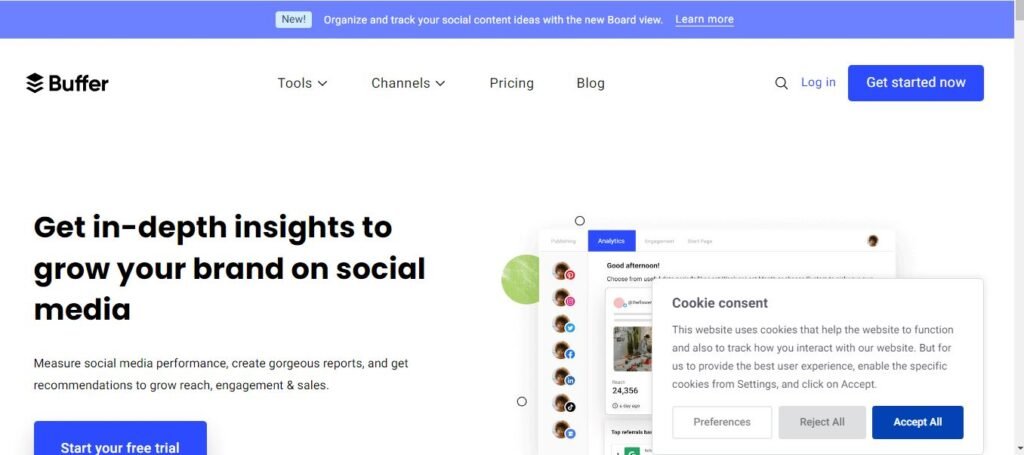
Dashboards and Reports
Importance of creating dashboards and regular reports for monitoring metrics:
#1. Data Visualization: Dashboards and reports provide visual representations of key ad metrics, making it easier to identify trends, patterns, and areas for improvement at a glance.
#2. Performance Tracking: Regularly monitoring metrics through dashboards and reports allows marketers to track the progress of their ad campaigns over time and make data-driven decisions to optimize performance.
#3. Communication and Collaboration: Dashboards and reports can be shared with stakeholders and team members to communicate campaign performance, align on goals, and collaborate on optimization strategies.
#4. Continuous Improvement: By regularly reviewing and analyzing ad metrics through dashboards and reports, marketers can identify opportunities for optimization, refine targeting and messaging, and ultimately improve the overall effectiveness of their Facebook Ad campaigns
Making Data-Driven Decisions: A Roadmap to Ad Success
In the ever-evolving landscape of digital marketing, making data-driven decisions is not just a best practice, it’s a necessity. With a plethora of metrics at your disposal, understanding how to analyze and interpret them is crucial for optimizing ad performance, maximizing ROI, and achieving your marketing objectives.
In this guide, we provide a step-by-step roadmap to help you navigate the process of making data-driven decisions in your Facebook advertising campaigns.
Analyzing Metrics: Unveiling Insights for Action
#1. Define Your Goals: Begin by clearly defining your marketing objectives and key performance indicators (KPIs). What are you trying to achieve with your Facebook ad campaigns? Whether it’s driving website traffic, increasing conversions, or boosting brand awareness, align your metrics with your goals.
#2. Gather Data: Utilize Facebook Ads Manager and other analytics tools to collect relevant data on your ad performance. Compile metrics such as impressions, clicks, CTR, CPC, conversion rate, and ROAS across your campaigns, ad sets, and individual ads.
#3. Segment and Compare: Segment your data based on different variables such as audience demographics, ad placements, and campaign objectives. Compare performance metrics between different segments to identify trends, patterns, and areas of opportunity.
#4. Identify Trends and Patterns: Analyze your data to uncover trends and patterns that shed light on what’s working and what’s not. Look for correlations between specific ad elements (e.g., ad copy, visuals) and performance metrics to understand their impact on ad effectiveness.
#5. Diagnose Performance Issues: Identify any underperforming areas or outliers in your data. Pinpoint factors contributing to low performance, such as ineffective targeting, ad fatigue, or suboptimal ad creative.
#6. Draw Insights: Synthesize your data analysis into actionable insights. What are the key takeaways from your data? What are the strengths and weaknesses of your ad campaigns? Use your insights to inform strategic decisions and optimizations.
Adjusting Strategies: Optimizing for Success
#1. Iterative Testing: Based on your insights, develop hypotheses for improving ad performance. Implement A/B tests to experiment with different variables such as ad copy, visuals, audience targeting, and bidding strategies.
#2. Optimization Tactics: Make targeted adjustments to your ad campaigns to address identified performance issues. Optimize ad creative, refine audience targeting parameters, adjust bidding strategies, or reallocate budgets based on your insights.
#3. Monitor Performance: Continuously monitor the impact of your optimizations on ad performance. Track how changes affect key metrics over time and iterate based on real-time data feedback.
#4. Scale Successful Strategies: Identify strategies and tactics that yield positive results and scale them across your ad campaigns. Double down on high-performing ad creative, audience segments, or campaign structures to maximize ROI.
#5. Adapt to Changes: Stay agile and responsive to changes in the digital landscape. Keep abreast of industry trends, algorithm updates, and shifts in consumer behavior, and adjust your strategies accordingly.
Continuous Improvement: The Path to Sustained Success
#1. Embrace Iteration: Understand that optimization is an ongoing process, not a one-time task. Continuously iterate on your ad campaigns, testing new ideas, and refining your strategies based on evolving data and insights.
#2. Data-Driven Decision Culture: Foster a culture of data-driven decision-making within your organization. Encourage collaboration between marketing, analytics, and creative teams to leverage insights and drive better outcomes.
#3. Invest in Learning: Stay curious and invest in learning opportunities to deepen your understanding of Facebook ad metrics and optimization strategies. Attend industry conferences, workshops, and training sessions to stay ahead of the curve.
#4. Celebrate Successes and Learn from Failures: Celebrate wins and successes, but also embrace failures as learning opportunities. Analyze what worked well and what didn’t, and use those insights to inform future strategies.
#5. Stay Committed to Excellence: Commit to excellence in your Facebook advertising efforts. Strive for continuous improvement, innovation, and excellence in all aspects of your ad campaigns, from targeting and creative to optimization and measurement.
By following this roadmap to making data-driven decisions in your Facebook advertising campaigns, you’ll be better equipped to optimize performance, drive results, and achieve your marketing goals. Remember, data is your compass in the digital wilderness—let it guide you toward success
Conclusion
In this comprehensive guide, we’ve embarked on a journey through the realm of tracking and analyzing Facebook Ad metrics, uncovering insights and strategies to empower your advertising success. Let’s recap the key points covered:
We explored essential Facebook Ad metrics, from impressions and reach to conversion rate and return on ad spend (ROAS). Each metric offers valuable insights into ad performance, audience engagement, and campaign effectiveness.
We delved into the tools and platforms available for tracking and analyzing Facebook Ad metrics, including Facebook Ads Manager, third-party analytics tools, and the importance of dashboards and reports for visualizing data.
We provided a step-by-step roadmap for making data-driven decisions in your Facebook advertising campaigns, from analyzing metrics to adjusting strategies based on insights and driving continuous improvement.
Now, it’s time to take action. Take the first step towards optimizing your Facebook ad campaigns by tracking your ad metrics. Dive into Facebook Ads Manager, explore your data, and gain insights into your ad performance.
Armed with insights from your data analysis, optimize your ad strategies to maximize ROI and achieve your marketing objectives. Experiment, iterate, and refine your campaigns based on real-time feedback.
Keep an eye on emerging trends and changes in Facebook Ad metrics. The digital landscape is ever-evolving, so stay informed and adapt your strategies accordingly to maintain a competitive edge.
As you embark on your journey to Facebook ad success, remember that knowledge is power. By harnessing the insights gleaned from tracking and analyzing your ad metrics, you have the tools to drive meaningful results and propel your business forward in the digital age. So, go forth, embrace data-driven decision-making, and unleash the full potential of your Facebook advertising campaigns. Your success awaits!



